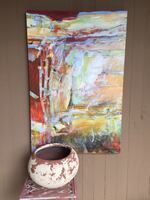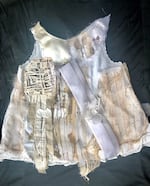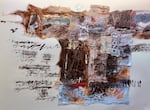Artist and educator Judy Hoiness has lived and worked in Bend, Oregon, for some 45 years. Primarily a painter, her work is often described as abstract landscapes that incorporate calligraphic marks, collage and mixed media. But the breadth of Hoiness’ work doesn’t stop there.

Inspired by Oregon's high desert, Bend artist Judy Hoiness' imaginative paintings excavate the landscapes that her family has called home for six generations.
Jule Gilfillan / OPB
“I think I heard this quote once, I think it was from Louis Armstrong and it says: ‘The cats I like best are the cats that take chances.’ And I thought: Wow, that sounds really great! That’s what I like to do,” says Hoiness.
Over a long career of both artmaking and teaching, Hoiness has traveled through the creative worlds of representation, improvisation and imagination. Today in her basement studio, Hoiness is working on a long-term project called “The Great Basin: What is and what might have been.” The work consists of drawings, paintings as well as textile pieces that explore the everyday lives of the area’s original people and emigrant pioneers.
“I’m really enjoying the ‘what-might-have-been’ part,” says Hoiness. “I’m the inventor.”
One of the project’s series invents a kind of archeology of little girls’ dresses.

A little pioneer girl's dress reimagined is part of the series "The Great Basin: What is and what might have been," by Bend artist Judy Hoiness.
Courtesy of Judy Hoiness
“Where I live in Bend, we’re right on the edge of the northern part of the Great Basin. And the pioneers passed through that area too. So I’ve been thinking about: What did they think? What were they doing? And what kinds of things did they leave accidentally?”
To invite the element of risk into her creative process, Hoiness collects vintage clothes from local thrift shops, wraps them around assortments of old tools and metal objects, then buries them in her garden. When the bundles are excavated some months later, the antique fabrics are imprinted with rust and stains suggesting what the garment might have gone through after 100 years in the unforgiving high desert landscape.

Bend artist Judy Hoiness imagines "what might have been" left behind on a pioneer's journey through the Great Basin by creating art using recycled cloth, applique and calligraphic marks.
Courtesy of Judy Hoiness
In some cases, Hoiness makes art with the excavated fabrics. In others, she draws on them as a “gold mine” of inspiration and ideas. Applying paint, stain or stitching to recycled cloth, she recreates the shapes and colors she sees on the buried textiles to make something new.
“I’m painting on and tearing and ripping and sewing and making a new dress out of just scraps. To me, it represents a child had something brand new and then the child lived and went through the Great Basin into Oregon and the dress becomes torn apart, maybe a little piece gets snagged.”
Combining the natural delicacy of a child’s garment with the earthy impact of the rugged landscape and the passage of time, the results are haunting and evocative.
“When you look at pieces that have stains, tears, patches, where someone has very painstakingly sewed a patch, that also holds so many memories. Why can’t I give it another life?”
Already several years into the Great Basin project, Hoiness continues to be fascinated with the land and life forms she finds there, or imagines might have been.

Elijah and America Bailey, Judy Hoiness' great-great grandparents. Elijah traveled from Kansas to Oregon on a cattle drive and liked it so much that he moved his whole family out.
Courtesy of Judy Hoiness
“My great-great-grandfather came to Oregon on a cattle drive and liked it so well, went back and got his family. So, I’m fourth-generation. My grandkids are sixth-generation Oregonians. It’s in my art. I can’t help it. It just comes out. It’s what I am. I don’t think I could get out of it,” she confesses. “I’ll probably be on that project for the rest of my life.”
